When presented with the opportunity to select a scholarly project, I knew that I wanted it to involve radiology. Knowing this, I immediately went to my previous mentor, Dr. Ronald Korn, to see if he had any opportunities for me; luckily he did. He gave me the chance to work in a field that I found fascinating, Quantitative Textural Analysis (QTA). It is a new, up-and-coming subsection of radiology that enables scans to be analyzed on their relative pixel densities, allowing for an even further investigation of an image. The specific modality that I am using for my project is TextRad.
The way that TextRad works is by breaking down the image into particles, then analyzing each particle’s density. It compares a pixel’s density with the subsequent pixels surrounding it, giving a measure of the heterogeneity of the tissue. The greater the difference between pixel densities, the greater the heterogeneity. The reason that this is so important is because a hallmark of cancer is tissue heterogeneity. Due to this, QTA can be used as an ancillary method to help determine heterogeneous, malignant tissue.
My scholarly project entails working with patients who were diagnosed previously with non-small cell lung cancer (NSCLC) stages I/II. This specific subset of cancer was chosen due to its high recurrence rate, approximately 39% within 5 years. If there is some way to analyze a patient’s scans to see if the cancer is more susceptible to recurrence, it could impact the treatment. Because of this, Dr. Korn and I are asking our research question: Can TextRad technology performed on pre-operative CT scans predict the recurrence of cancer in patients with stage I and stage II NSCLC?


The patient population will be selected through the HonorHealth tumor registry. The criteria for each patient are that they must have been diagnosed with NSCLC stage I/II, and they must have negative margins post-surgical resection. Two separate groups will be analyzed: those that had a subsequent recurrence and those who did not. A 1 X 1-cm region of interest will be drawn manually on the scans. The TextRad technology will be run on both groups. The textural analysis quantities will be subtracted to determine if there is a significant difference between the two groups. The quantities include the mean positive pixel value, entropy, skewness, and kurtosis.
Overall, we believe that TextRad is capable of detecting a signature difference between patients with NSCLC stage I/II who had a recurrence versus those who did not. This insight cannot only help screen high-risk patients, it can also help personalize those patients’ treatments. Therefore, there is the possibility of increasing the long-term survival rate for this patient population. From all of this, I am very excited to see the outcome of this study and am very thankful for this opportunity.
Melissa Gordon is a medical student in the Class of 2019 at The University of Arizona College of Medicine – Phoenix. She graduated from The University of Arizona in 2015 with a Bachelor of Science in physiology and a Bachelor of Science in psychology. Melissa enjoys writing in her spare time.

